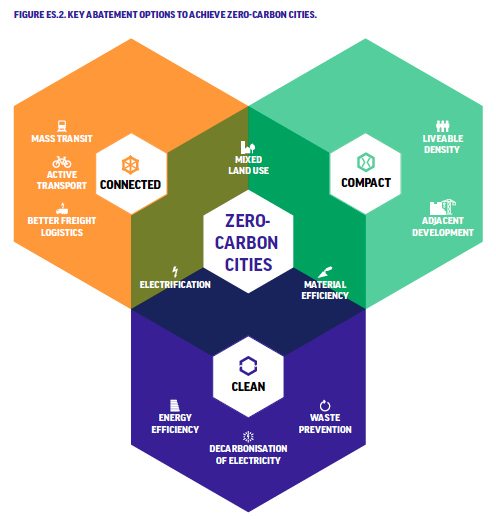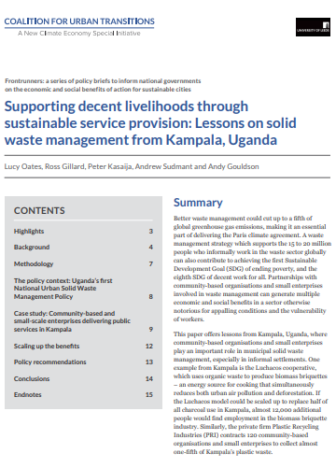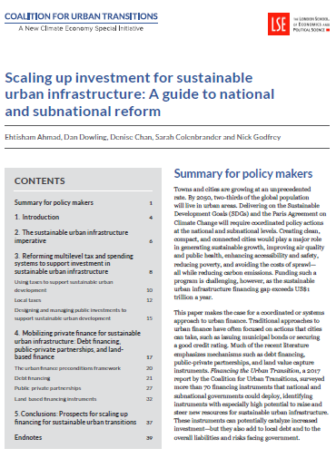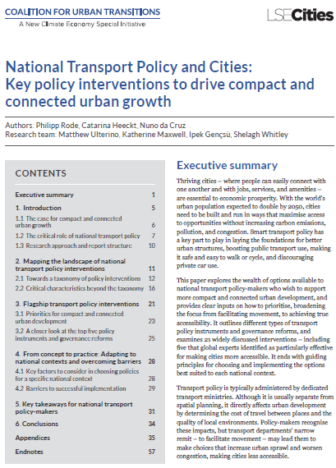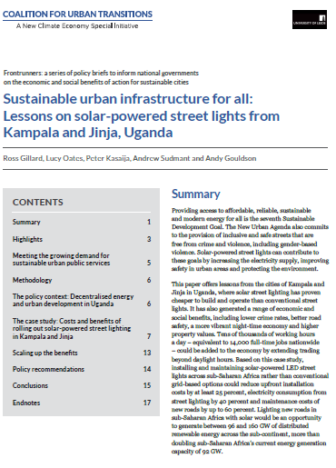The world faces a climate emergency – but cities offer national governments a solution. Rising temperatures are already causing serious loss of life and threatening vital ecosystems. Further increases pose an existential threat to entire cities and countries. The battle for the planet will be won or lost in cities. Over half the world’s population lives in urban areas, which produce 80% of gross domestic product and three quarters of carbon emissions from final energy use.1 And the share of people, economic activity and emissions in cities is growing rapidly, especially in Africa and Asia.
This report shows that a carefully managed transition to zero-carbon, climate-resilient cities could help secure national economic prosperity and improve quality of life while tackling the climate crisis. Science tells us that to keep global temperatures from rising by more than 1.5°C, cities have to achieve net-zero emissions by mid-century.2 New analysis conducted for this report shows that greenhouse gas emissions from cities can be reduced by almost 90% by 2050 using technically feasible, widely available mitigation measures. If designed and delivered with care, these measures could also address urgent political priorities, including choking air pollution, chronic traffic congestion, poor services and lost productivity. The bundle of investments would collectively generate an economic return worth US$23.9 trillion in today’s terms. The leading countries of tomorrow will be those whose cities can successfully make an equitable and sustainable transition to a new urban economy.
Action by city governments is critical, but on its own, it cannot achieve this goal. There has been a groundswell of local-level climate action in recent decades. City governments have shown particular leadership: nearly 10,000 cities and local governments worldwide have committed to set emission reduction targets and prepare strategic plans to deliver on them.3 However, even the largest and most empowered city governments can deliver only a fraction of their mitigation potential unilaterally.4

Fewer than two in five
countries have an explicit
national strategy for cities,
and only a handful of these
speak meaningfully to
both climate action and
human development
National governments have unique and crucial roles to play in nurturing zero-carbon, climate-resilient cities. Many national and state policies are explicitly urban-focused, such as the design of spatial planning guidelines and the drawing of municipal boundaries. Many more, though not urban-specific, hugely influence the performance of cities, such as national energy, tax and transport policies. In addition, funding and financing mobilised by national and state governments is crucial for cities, particularly for large infrastructure projects. The future of cities therefore depends substantially on decisions made or support provided by higher levels of government. National governments formally recognised the importance of cities when they adopted the 11th Sustainable Development Goal (SDG11), which commits countries to “make cities and human settlements inclusive, safe, resilient and sustainable”. Yet today, fewer than two in five countries have an explicit national strategy for cities,5 and only a handful of these speak meaningfully to both climate action and human development. Worldwide, only seven countries have both a National Urban Policy and a Nationally Determined Contribution that specifically address climate mitigation in cities (although many more make sectoral-based commitments to decarbonise buildings, energy, transport and waste).

In Africa and Asia, the urban population is expected to grow by 2.5 billion people over the next 30 years
Cities will change dramatically in the coming decades. Technological innovation is enabling new forms of service delivery and transforming the nature of work, but also displacing many jobs. Demographic changes, from falling fertility to ageing populations, are driving demand for new forms of housing and services. Economic turbulence and structural economic change are redirecting global trade and investment. And in Africa and Asia, the urban population is expected to grow by 2.5 billion over the next 30 years.6 Business-as-usual modes of development are not delivering a decent standard of living for most people. Nearly a billion urban residents live in slums without access to decent housing, clean drinking water or safe sanitation.7 Too many workers toil in unsafe conditions for less than a living wage.
At the same time, immediate action is necessary to tackle the climate crisis. The world is on track for average temperatures to increase to at least 3°C above pre-industrial levels by the end of the century.8 That would lead to more frequent and catastrophic weather events, ecosystem collapse and possibly several metres of sea-level rise.9 These impacts will fall disproportionately on the poor and disenfranchised, eroding the development gains of recent decades and making it impossible to eradicate poverty. To hold global warming to 1.5°C above pre-industrial levels, carbon dioxide (CO2) emissions need to nearly halve by 2030 from 2010 levels and reach net-zero around 2050.10 As the major centres of production and consumption, what happens in cities in the next decade will be critically important to countries everywhere. National decision-makers can help put cities on a path to prosperity and resilience, or to decline and vulnerability.
This report shows that greenhouse gas emissions in cities can be brought close to net-zero using proven technologies and practices. It identifies a bundle of technically feasible low-carbon measures that could cut emissions from key urban sectors by almost 90% by 2050 (see Figure ES.1). In absolute terms, these savings are greater than the combined 2014 energy-related emissions of the two largest emitters, China and the US.11 58% of these carbon savings come from the buildings sector, 21% from the transport sector, 16% from materials efficiency and 5% from the waste sector. The investments required to reduce urban emissions would be US$1.83 trillion (about 2% of global GDP) per year,12 but they would generate annual savings worth US$2.80 trillion in 2030 and US$6.98 trillion in 2050. This yields a net present value of US$23.9 trillion.13 This estimate is conservative. With higher energy prices and faster technological learning rates, the net present value of these investments rises to US$38.19 trillion. These figures do not include wider benefits, such as long-run productivity gains or improved public health.
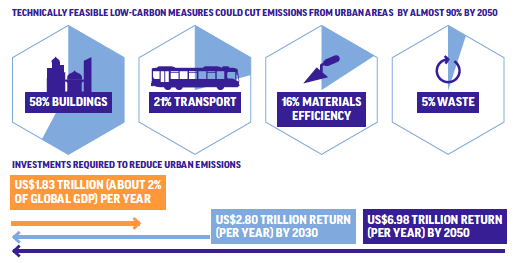
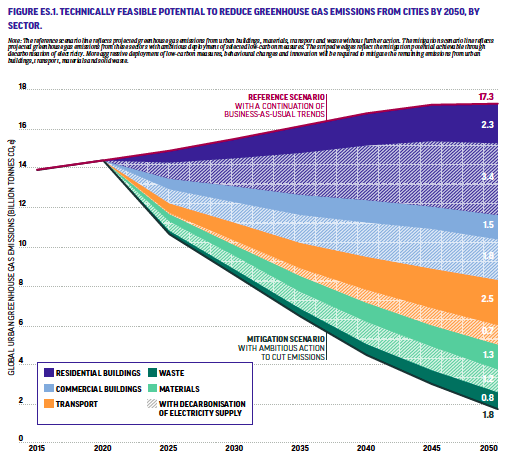
Proactive leadership from national governments and meaningful partnerships with other tiers of government are needed to seize this opportunity. Enabling policies and investments can stimulate climate action by the private and civic sectors. Over half of the abatement potential identified in this report comes from decarbonising electricity grids, which are typically overseen by national and provincial governments. Notably, over half of the total abatement potential is in urban areas with populations under 750,000, which often lack the financial and technical resources of larger cities. Indeed, new analysis for this report finds that, worldwide, national and state governments have primary authority over 35% of urban mitigation potential (excluding decarbonisation of electricity), including from improved cement production processes and more stringent efficiency standards for appliances, lighting and vehicles. Local governments have primary authority or influence over 28%, including compact urban form, travel demand management and waste disposal. 37% of the identified mitigation potential depends on collaborative climate action among national, regional and local governments, including building codes, decentralised renewables and mass transit infrastructure. Bold national leadership is therefore needed to deliver these emission reductions and provide an enabling environment for local action.
Zero-carbon cities will be places where people are healthier and more productive. The bundle of low-carbon measures identified in this report would make cities more compact, connected and clean (see Figure ES.2). It also offers an opportunity to eradicate poverty and improve living standards for all. In the future, people around the world could live in neighbourhoods where they can walk quickly and safely to work, school and parks, along quiet streets with plenty of places to meet and rest. Pedestrians and cyclists could enjoy protected sidewalks and paths lined with trees, shops and restaurants. Speed limits on the streets could be low enough that everyone feels safe crossing – even if they are elderly, disabled or pushing a pram. With steady foot traffic, local retailers and eateries would thrive. Well-maintained public transit could offer convenient and comfortable commutes, connecting every district so that people do not have to drive. The few vehicles on the streets could all be electric, quiet and pollution-free. With much cleaner air in cities, asthma, allergies and other respiratory diseases would be far less common. It would be more pleasant inside homes and commercial buildings, with increased natural lighting, good ventilation, and material and design choices that limit the need for temperature control. Combined with rooftop solar panels and highly efficient heating and cooling systems, compact, connected and clean cities would sharply reduce costs for households and businesses.
Case studies from around the world demonstrate that a rapid urban transition is possible. The vision presented here may seem far-fetched when millions of urban residents today live in deep poverty and degraded environments. Yet this report offers case studies from around the world – Medellín in Colombia, Copenhagen in Denmark, Indore in India, Seoul in Korea and Windhoek in Namibia – where national and local governments have worked together to profoundly improve the quality of life in cities within two or three decades. These examples show that the scale and pace of change required to achieve SDG11 and reach zero-carbon cities are both technically and politically feasible.
Pursuing compact, connected and clean cities also offers a huge opportunity for national governments to achieve faster, fairer economic development. This report finds that governments in the Organisation for Economic Co-operation and Development (OECD) and BRIICS (Brazil, Russia, India, Indonesia, China and South Africa) countries collectively spend US$41.6 billion a year subsidising fossil fuel consumption in urban areas. These subsidies effectively incentivise costly urban sprawl, toxic air pollution, traffic injuries and dangerous climate change. New approaches are needed to foster thriving cities. Policies and markets are already changing to support a new, low-carbon economy. Countries that do not proactively manage this transition will face stranded assets and stranded workers as high-carbon systems become unaffordable or no longer comply with evolving regulations.
National governments that anticipate these structural trends and place zero-carbon cities at the heart of their long-term national development and climate strategies will secure four economic advantages:
It is cheaper to provide infrastructure and services in more compact, connected and clean cities. Less land, materials and energy are required to physically connect households and firms when they are closer together, and higher densities make infrastructure investments more economically feasible, from metro systems to district heating and cooling. Moreover, many low-carbon measures are now more economically attractive than their high-carbon counterparts. The bundle of low-carbon measures identified in this report represents a US$23.9 trillion opportunity; adopting all these low-carbon measures would also support the equivalent of 87 million jobs in 2030 (mostly from deep building efficiency improvements) and 45 million jobs in 2050 (mostly in the transport sector).
The productivity of workers and businesses is higher in larger, more densely populated cities, particularly those with good public transport networks. A recent review of over 300 studies on compactness finds that a 10% difference in the number of people living and working in an area is worth about US$182 per person a year from higher productivity and better access to jobs and services.14
The transition to compact, connected and clean cities can build national capacity to both create and absorb innovations that will be critical for economic competitiveness in the future. This report finds that a 10% higher population density (measured by number of inhabitants per square kilometre) is associated with an additional 1.1% patents per 1000 people in Europe and an additional 1.9% in the US. Innovation in all its forms can have huge real-world impact. China, for instance, has supported its city governments to experiment with electric vehicles and charging infrastructure with impressive results: as of 2017, China was home to 40% of the world’s electric passenger cars and over 99% of the world’s electric buses.15

When these benefits are taken together, compact, connected and clean cities would offer countries a distinct competitive advantage as they seek to secure global talent and investment. Most countries seek to attract firms that produce tradeable goods and services. Because these firms can sell their products to a global market, they are not constrained by the size of local or regional markets. Firms and workers in these sectors are highly mobile, and are likely to be attracted to the direct cost savings, higher productivity and better quality of life associated with zero-carbon cities.
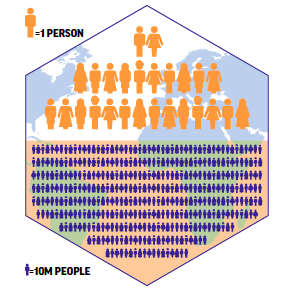
The world’s 26 wealthiest people own as many assets as the 3.8 billion people in the poorer half of the population
However, the full promise of zero-carbon cities cannot be achieved without meaningful progress to eradicate poverty and reduce inequality. Every transition has some trade-offs, and reaching net-zero emissions will require profound social and cultural changes. Citizens need to be confident that they will be protected from any negative impacts and that they will truly benefit from new ways of living, consuming, travelling and producing. Building public support for such a transformation will be difficult if profound deprivation and inequality persist. Today, the world’s 26 wealthiest people own as many assets as the 3.8 billion people in the poorer half of the population.16 This means that a few (powerful) people have a vested interest in the status quo, while many (voting) people feel vulnerable and are thus apprehensive about radical change – even if everyone benefits from ambitious climate action in the not-too-distant future. To make the most of this opportunity, national governments need to put equity and inclusion at the top of their agendas.
Ambitious climate mitigation is no longer enough to secure national prosperity; investments in urban resilience will be essential to cope with inevitable climate change. Global temperatures are already 1°C above pre-industrial levels,17 and the impacts are clear. In the last few years, cities from Ahmedabad in India, to Melbourne in Australia, to Rome in Italy suffered heatwaves in which temperatures exceeded 40°C.18 Cities from Cape Town in South Africa, to Chennai in India, to São Paulo in Brazil have all but run out of water.19 Much higher temperature increases are likely,20 and consequently much more severe climate hazards. With their concentration of people, assets and economic activity, cities are hotspots of vulnerability. New analysis for this report finds that 710 million people live in coastal urban and quasi-urban areas less than 10 metres above sea level; more than three quarters of them live in Asia. In low-lying countries such as the Netherlands, Thailand and Viet Nam, over half the urban population lives in coastal settlements less than 10 metres above sea level. Nearly 10% of the world’s land within 10 metres above sea level is already urban or quasi-urban, compared with 2% elsewhere. This means that storm surges and sea-level rise are now overwhelmingly urban threats. Urban adaptation will be critical to minimise the devastation that climate change will wreak upon national economies and societies.
National governments have many opportunities to simultaneously support climate mitigation, adaptation and sustainable development in cities. For example, more compact cities can safeguard cultivated land and natural habitats around the urban periphery, protecting carbon stocks stored in biomass and soils. Avoiding land use change can also protect biodiversity and crucial ecosystem services such as pollination, soil formation and nutrient recycling. Sustaining oceanic and agricultural productivity is particularly important in the context of the climate crisis, which threatens to reduce yields from fish stocks and staple crops such as wheat, maize and rice.21 Despite the importance of managing urban expansion, sprawl is happening apace. New analysis for this report finds that, between 2000 and 2014, urban areas expanded by an amount roughly equivalent to two Sri Lankas. Two thirds of this urban expansion was in Asia, and one fifth was in Africa, where millions of people depend on fishing, forestry and farming for their livelihoods.
More sustainable urban development can therefore support and stimulate rural development as well. This report presents six key priorities for actions that national governments should take to seize this opportunity. These priorities for national action (summarised in Figure ES.3) are grounded in three years of research and an extensive consultation process involving over 50 institutions: research institutes, networks of national and city governments, investors, infrastructure providers, strategic advisory companies, non-governmental organisations and social movements. The priorities for national action were tested with representatives of national and city governments to confirm their feasibility and relevance. The breadth of these recommendations reflects the interconnectedness and centrality of cities to wider national development, and the myriad ways in which they are influenced by national policies.
Within each priority for national action, this report offers an array of measures to suit different contexts and recommendations for how to sequence them. National governments can realise the economic, social and environmental advantages of zero-carbon cities in multiple ways. Some measures focus narrowly on urban and climate outcomes; others would create economy-wide conditions for a zero-carbon urban transition. Policy-makers can select specific instruments according to their national circumstances and development objectives. While not all options identified will be appropriate for every country, the toolbox as a whole has relevance to countries at all levels of development.
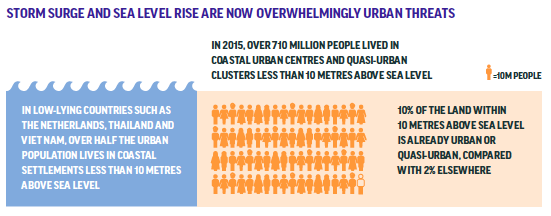
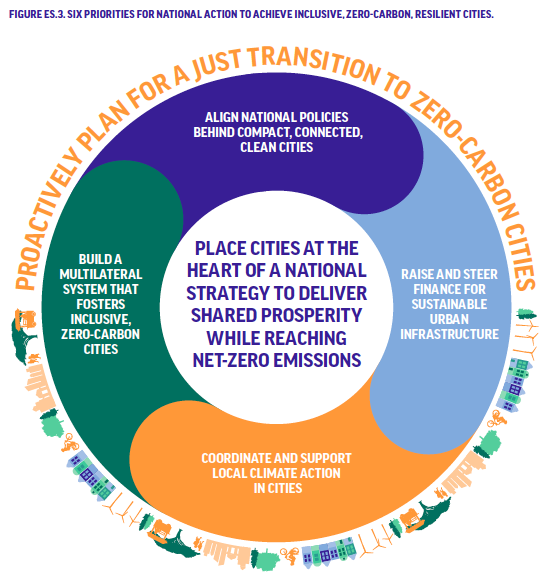
The six priorities for national action are:
- Develop an overarching strategy to deliver shared prosperity while reaching net-zero emissions – and place cities at its heart. Few national governments have robust plans to deliver economic and social development in the context of a climate emergency. Given the growing share of people, economic activity and emissions concentrated in cities, any such plan needs to have a meaningful urban dimension. A comprehensive national strategy, focused on compact, connected, clean cities and underpinned by a genuine partnership between national and local governments, could eradicate poverty, reduce inequality and avoid climate catastrophe. Such a strategy should be grounded in a shared vision for the future of cities, and their links to country-wide development. It can inspire every line ministry to approach urban development in a considered and purposeful way, de-risk low-carbon investment by providing clear signals to private actors, and empower local governments to go farther and faster on low-carbon, climate-resilient development.
- Align national policies behind compact, connected, clean cities. Key measures include removing land use and building regulations that limit higher density; reforming energy markets to decarbonise the electricity grid; reaching net-zero operating emissions in all buildings with minimal use of carbon offsets; decarbonising the electricity grid; banning the sale of fossil fuel-powered vehicles; adopting green alternatives to steel and cement; and shifting away from building detached housing in established cities. Senior decision-makers in India, for example, are suggesting that the sale of fossil fuel-powered passenger cars and two-wheelers will be prohibited from 2030.22
- Fund and finance sustainable urban infrastructure. Key measures include eliminating subsidies for fossil fuels; establishing a carbon price of US$40–80 per tonne, which should then increase over time; working with local governments to establish a pipeline of climate-safe, bankable projects to anchor compact, connected, clean urban development; scaling land-based financing instruments to fund sustainable urban infrastructure and limit sprawl; and shifting national transport budgets from road-building to public and active transport. As of 2018, 45 countries have put a price on carbon, including emerging economies such as Chile, China, Colombia, Mexico and South Africa.23

As of 2018, 45 countries have put a price on carbon, including emerging economies such as Chile, China, Colombia, Mexico and South Africa
- Coordinate and support local climate action in cities. Key measures include passing legislation explicitly clarifying the roles and powers of different tiers of government, including measures to enhance own-source revenue options; creating integrated land use and transport authorities for cities; strengthening local capacities to act on climate change; authorising local governments to introduce climate policies and plans that are more ambitious than national policies; establishing “regulatory sandboxes” for low-carbon innovations in cities; and allocating at least a third of national research and development (R&D) budgets to support cities’ climate priorities. Between 2000 and 2018, Germany expanded the share of renewable electricity from 6% to over 38%, largely through the Renewable Energy Sources Act, which empowered municipal authorities and citizen cooperatives.
- Build a multilateral system that fosters inclusive, zero-carbon cities. Key measures include scaling up collaborative climate action in cities in the Nationally Determined Contributions; requiring all international financial institutions to end all fossil fuel financing; ensuring that all international development assistance is aligned with national urban strategies that are compatible with the Paris Agreement and the 2030 Agenda for Sustainable Development; establishing an international carbon price floor; and helping city governments to access international public finance for low-carbon, climate-resilient development (with adequate sovereign oversight). Mexico, for example, has been systematically recording climate policies and projects by states and municipalities, and will use them to enhance national ambition in the next round of the climate negotiations.
- Proactively plan for a just urban transition. Key measures include strengthening tenure security for the urban poor; enhancing climate resilience and gender equality by educating all young people; using revenues from fossil fuel subsidy reform or carbon taxes to compensate people who bear the costs of climate action; supporting local governments to make well-located, serviced land available for growing urban populations; supporting community-led upgrading of informal settlements; and anticipating, protecting and supporting the workforce of the future, including by developing transition plans for fossil fuel-based workers and industries. Namibia, for instance, has accommodated most of the rapid increase in its urban population by making small plots of serviced, competitively priced land available in cities, reducing the heavy health and economic burden associated with informal settlement.
Pursuing zero-carbon, resilient cities in an inclusive way will simultaneously raise countries’ living standards, tackle inequality and address the climate crisis. For national leaders, creating such cities would yield short-term political dividends and secure long-term national prosperity. It is an opportunity not to be missed.
References
1 UN-DESA, 2018. World Urbanization Prospects 2018. United Nations Department of Economic and Social Affairs, New York. Available here.
Dobbs, R., Smit, S., Remes, J., Manyika, J., Roxburgh, C., Restrep, A., 2011. Urban World: Mapping the Economic Power of Cities. McKinsey Global Institute. Available here.
Seto, K.C., Dhakal, S., Bigio, A., Blanco, H., Delgado, G.C., et al., 2014. Human settlements, infrastructure, and spatial planning. In: Climate Change 2014: Mitigation of Climate Change. Contribution of Working Group III to the Fifth Assessment Report of the Intergovernmental Panel on Climate Change. O. Edenhofer, R. Pichs-Madruga, Y. Sokona, E. Farahani, S. Kadner, et al. (eds.). Cambridge University Press, Cambridge, UK, and New York. Available here.
2 Bazaz, A., Bertoldi, P., Cartwright, A., de Coninck, H., Engelbrecht, F., et al., 2018. Summary for Urban Policymakers: What the IPCC Special Report on Global Warming of 1.5°C Means for Cities. Intergovernmental Panel on Climate Change, Geneva. Available here.
3 Global Covenant of Mayors for Climate & Energy, 2019. Implementing Climate Ambition: Global Covenant of Mayors 2018 Global Aggregation Report. Brussels. Available here.
4 C40 Cities Climate Leadership Group, 2014. C40 Cities: The Power to Act. London. Available here.
5 76 countries have an explicit National Urban Policy (NUP), i.e. a country has a policy called “National Urban Policy”, “National Urbanisation Policy”, “National Urban Strategy” or a similarly close variant. 74 countries have an implicit or partial NUP, i.e. a country has many of the elements of a NUP in place but these are not brought together in a formal or explicit NUP. There are 195 countries. Source: UN-Habitat and OECD, 2018. Global State of National Urban Policy. Organisation for Economic Co-operation and Development, Paris. Available here.
6 UN-DESA, 2018. World Urbanization Prospects 2018.
7 UN-Habitat, 2016. Slum Almanac 2015–16. United Nations Human Settlements Programme, Nairobi. Available here.
8 New Climate Institute, Ecofys and Climate Analytics, 2018. Climate Action Tracker. Available here.
9 IPCC, 2014. Climate Change 2014: Synthesis Report. Core Writing Team, R. K. Pachauri, and L. A. Meyer (eds.). Intergovernmental Panel on Climate Change, Geneva. Available here.
Goodell, J., 2017. The Water Will Come: Rising Seas, Sinking Cities, and the Remaking of the Civilized World. Hachette, New York. Hansen, J. E., 2007. Scientific reticence and sea level rise. Environmental Research Letters, 2(2). 024002. DOI:10.1088/1748-9326/2/2/024002.
Vermeer, M. and Rahmstorf, S., 2009. Global sea level linked to global temperature. Proceedings of the National Academy of Sciences of the United States of America, 106(51). 21527–21532. DOI:10.1073/pnas.0907765106.
10 Bazaz et al., 2018. Summary for Urban Policymakers.
11 China and the US had combined energy-related emissions of 15.1GtCO2-e in 2015. See: WRI, 2019. Climate Watch Data Explorer. World Resources Institute, Washington, DC. Available here.
12 Based on global GDP of US$84.74 trillion. See: IMF Data Mapper,
2019. GDP, current prices: Billions of US dollars. International Monetary Fund, Washington, DC. Available here.
13 Based on global GDP of US$84.74 trillion. See: IMF Data Mapper, 2019. GDP, current prices.
14 Ahlfeldt, G., and Pietrostefani, E., 2017. Demystifying Compact Urban Growth: Evidence From 300 Studies From Across the World. Coalition for Urban Transitions, London and Washington, DC. Available here.
15 IEA, 2018. Global EV Outlook 2018: Towards Cross-Modal Electrification. International Energy Agency, Paris. Available here.
16 Lawson, M., Chan, M.K., Rhodes, F., Butt, A.P., Marriott, A., et al., 2019. Public Good or Private Wealth? Oxfam. Available here.
17 IPCC, 2018. Summary for Policymakers. In: Global Warming of 1.5°C. An IPCC Special Report on the impacts of global warming of 1.5°C above pre-industrial levels and related global greenhouse gas emission pathways, in the context of strengthening the global response to the threat of climate change, sustainable development, and efforts to eradicate poverty. V. Masson-Delmotte, P. Zhai, H.-O. Pörtner, D. Roberts, J. Skea, et al. (eds.). Intergovernmental Panel on Climate Change, Geneva. Available here.
18 2019. Heat wave: Red alert over heat in Gujarat during weekend. Times of India. Available here.
Snaith, E., 2019. ‘The worst is still to come’: Heatwave sees roads melt, rail tracks buckle and schools closed as 44C temperatures scorch Europe. The Independent, 27 June. London. Available here.
Wahlquist, C., 2019. Melbourne heatwave: city expecting 44C as Victoria faces hottest day since Black Saturday. The Guardian, 25 January. Available here.
19 Alexander, C., 2019. Cape Town’s ‘Day Zero’ Water Crisis, One Year Later. CityLab, April. Available here.
Pathak, S., 2019. No Drips, No Drops: A City Of 10 Million Is Running Out Of Water. National Public Radio, 25 June. Available here.
Ritter, K., 2018. São Paulo Heading To Another Dry Spell. Circle of Blue. S.o Paulo, Brazil. Available here.
20 IPCC, 2018. Summary for Policymakers.
21 Hoegh-Guldberg, O., Jacob, D., Taylor, M., Bindi, M., Brown, S., et al., 2018. Impacts of 1.5C global warming on natural and human systems. In: Global Warming of 1.5°C. An IPCC Special Report on the impacts of global warming of 1.5°C above pre-industrial levels and related global greenhouse gas emission pathways, in the context of strengthening the global response to the threat of climate change, sustainable development, and efforts to eradicate poverty. V. Masson-Delmotte, P. Zhai, H.-O. Pörtner, D. Roberts, J. Skea, et al. (eds.). Intergovernmental Panel on Climate Change, Geneva. Available here.
22 Sanjai, P. R., Singh, R. K., 2017. 10,000 Electric Cars Highlight Steep Path to India’s Ambitions. Bloomberg News. Available here.
23 World Bank and Ecofys, 2018. State and Trends of Carbon Pricing 2018. World Bank, Washington, DC. Available here.
